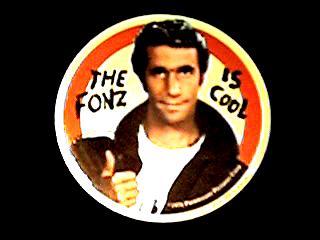Say one thing well
JULES: C’mon Yolanda, what’s Fonzie like?
YOLANDA: (through tears, unsure) He’s cool?
JULES: Correct-amundo!
Script for Pulp Fiction, by Quentin Tarantino and Roger Avary
Like a dark, hypnotic jewel, the character of Arthur Fonzarelli had many facets. Wearing a leather jacket, talking to his own reflection, jumping over sharks. But if you ask most people to describe him in one word, they’ll say he was cool.
The Fonz is cool. That’s what he says, that’s how he acts, that’s his key value as a brand. And if we look at many other successful brands, we find they’re strongly associated with a single value, usually expressed as a single word. Volvos are safe. Asda is cheap. Nintendo is fun.
There’s a lot we can learn from their example – and not just for highflown branding projects. People’s attention is limited, and you get more of it if you don’t try to stretch it too thinly.
Imagine asking a group of women what they love most about their husbands. One says he’s kind, charming, thoughtful, generous and handsome. Another simply says he makes her laugh. Whose opinion will you remember the next day?
Of course, not every brand, product or value proposition can be reduced to one word. Complex technical products and B2B services are very often tough to boil down to pithy phrases that don’t sound glib. But when it comes to developing the messages about a brand or product, it still pays to focus on, or organise around, a single idea.
Dilution and ambiguity
Trying to cover too many ideas dilutes the audience’s cognitive resources and introduces ambiguity over the key message. It turns a straight-line narrative route into a garden of forking paths. It can only reduce the space you devote to hammering home the key idea. And, most importantly, it sends an implicit message of uncertainty and bet-hedging.
What constitues ‘too many ideas’ depends on context. For a short-copy ad, ‘too many’ means ‘more than one’. The copywriter is looking for copy, imagery and layout to dramatise a single key benefit in an arresting and memorable way. Anything beyond that is not needed. Company taglines are also strongest when they express just one corporate character trait, instead of trying to cram in two or three.
The three-sentence rule
Longer copy assignments, obviously, will have more points to make. But they’ll still need a unifying theme or structure. And each paragraph will still need to say as few things as possible – ideally, just one.
Although writing to a formula is probably a bad idea, there’s a lot to be said for three sentences per paragraph. The first introduces an idea, the second develops or explains it and the third adds proof or punch. See how I’ve done it in this paragraph, and several others in this post.
Feature creep
It’s natural for projects to pick up content themes over time, like a snowball rolling down a mountain – the phenomenon known as ‘feature creep’ in tech product development. So achieving one-idea focus may involve getting rid of distracting extra stuff, or perhaps reassigning it to another campaign or publication where it will be more valuable.
Getting clients to accept this can be tough, particularly if it means a cost increase. However, don’t underestimate writers’ own tendency to flam up the froth. Ironically, this post started off as part of a much longer piece about ‘five common copy problems’.
The process can be challenging, but the outcome is worth it. While you may feel something’s been lost, what you’ve gained is more important: copy that you can be confident in, with the best possible chance of being read and remembered.
Tags: Arthur Fonzarelli, Asda, Branding, feature creep, Fonz, Jules Winnfield, Jumping the shark, Nintendo, personal branding, Pulp Fiction, Volvo, Yolanda
